Today Current Affairs: 26th June 2021 for UPSC IAS exams, State PSC exams, SSC CGL, State SSC, RRB, Railways, Banking Exam & IBPS, etc
Table of Contents
INS Vikrant: First Indigenous Aircraft Carrier:

India’s Defence Minister reviewed the ongoing work on the Indigenous Aircraft Carrier (IAC), INS Vikrant (IAC-1), which is a part of Atmanirbhar Bharat.
- INS Vikrant, is likely to be commissioned in 2022.
- At present, India has only one aircraft carrier, the Russian-origin INS Vikramaditya.
- Earlier, the Defence Acquisition Council (DAC) approved issuance of Request for Proposal (RFP) for six advanced submarines for the Indian Navy under Project-75I.
- The vessel, to be named Vikrant after the decommissioned maiden carrier of the Navy.
- It will have an air component of 30 aircraft, comprising MiG-29K fighter jets, Kamov-31 airborne early warning helicopters and the soon-to-be-inducted MH-60R multi-role helicopter, besides the indigenous Advanced Light Helicopters.
- It is expected to have a top speed of 30 knots (approximately 55 kmph) and is propelled by four gas turbines.
- Its endurance is 7,500 nautical miles at 18 knots (32 kmph) speed.
- The shipborne weapons include Barak LR SAM and AK-630, while it has MFSTAR and RAN-40L 3D radars as sensors.
- The vessel has a Shakti EW (Electronic Warfare) Suite.
- It has a pair of runways and a ‘short take off but arrested recovery’ system to control aircraft operations.
Survey Of Forest Areas Project:
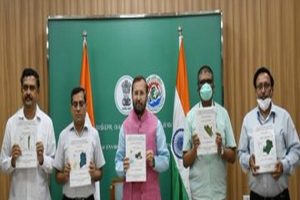
The Union Environment Minister in a virtual event released the Detailed Project Reports (DPRs) of LiDAR (Light Detection and Ranging) based survey of forest areas in ten states.
- The 10 mapped states are Assam, Bihar, Chhattisgarh, Goa, Jharkhand, Madhya Pradesh, Maharashtra, Manipur, Nagaland, and Tripura.
Survey of Forest Areas Project:
- The project was awarded to WAPCOS in July 2020 at a cost of over Rs. 18 crore for implementation in 26 states over 261897 hectares.
- WAPCOS is a Mini Ratna Public Sector Undertaking (PSU) under the Jal Shakti Ministry.
- It is a first of its kind and a unique experiment using LiDAR technology which will help augment water and fodder in jungle areas thereby reducing human-animal conflict.
- LiDAR technology has been found to have 90% accuracy.
- States will be given Compensatory Afforestation Fund Management and Planning Authority (CAMPA) funds to use in this project.
- CAMPA is meant to promote afforestation and regeneration activities as a way of compensating for forest land diverted to non-forest uses.
- CAMPA was established to manage the Compensatory Afforestation Fund (CAF) and it acts as the custodian of the CAMPA fund.
- One major ridge inside a forest block is identified in these states with an average area of 10,000 ha selected in each State; the area should have average rainfall of the state, and requires assisted natural generation.
- Besides reducing human-animal conflict, it will help us in identifying areas which need groundwater recharge which will in turn help local communities.
- It will help in catching rainwater and prevent stream run-off, which will help in recharging groundwater.
- It will help in recommending different types of Soil & Water conservation structures such as Anicut, Gabion, Gully Plug, Mini percolation tank, Percolation Tank, Field bund, Sunken pond, Farm pond etc.
LiDAR:
- It is a remote sensing method that uses light in the form of a pulsed laser to measure ranges & variable distances.
- These light pulses—combined with other data recorded by the airborne system— generate precise, three-dimensional information about the shape of the Earth and its surface characteristics.
- A LiDAR instrument principally consists of a laser, a scanner, and a specialized Global Positioning System (GPS) receiver.
- Airplanes and helicopters are the most commonly used platforms for acquiring LiDAR data over broad areas.
- LiDAR follows a simple principle — throw laser light at an object on the earth surface and calculate the time it takes to return to the LiDAR source.
- Given the speed at which the light travels (approximately 186,000 miles per second), the process of measuring the exact distance through LiDAR appears to be incredibly fast.
Ambergris:

The Mumbai Police has arrested five people and seized nearly 9 kg of Ambergris.
- Ambergris, French for grey amber, is generally referred to as whale vomit.
- It is a solid waxy substance originating in the intestine of the sperm whale.
- Ambergris is produced only by an estimated 1% of sperm whales.
- Chemically, ambergris contains alkaloids, acids, and a specific compound called ambreine, which is similar to cholesterol.
- It floats around the surface of the water body and at times settles on the coast.
- Because of its high value it is referred to as floating gold. 1 kg of ambergris is worth Rs 1 crore in the international market.
Use:
- It is used in the perfume market, especially to create fragrances like musk.
- It is believed to be in high demand in countries like Dubai that have a large perfume market.
- Ancient Egyptians used it as incense. It is also believed to be used in some traditional medicines and as a spice.
Smuggling:
- Due to its high value it has been a target for smugglers especially in coastal areas.
- There have been several cases where the coastline of Gujarat has been used for such smuggling.
- Since the sperm whale is a protected species, hunting of the whale is not allowed.
- However, smugglers are known to have illegally targeted the fish in order to obtain the valuable Ambergris from its stomach.
Air Quality And Covid-19:
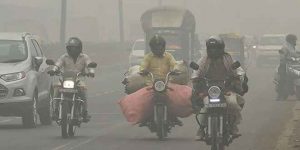
For the first time, a pan-India study has found a direct correlation between air pollution and Covid-19.
- The study found that areas with poor air quality and higher emissions of particulate matter (PM) 2.5 are more likely to have Covid-19 infections and related deaths.
- The study was conducted by scientists from various universities such as Indian Institute of Tropical Meteorology (IITM), Pune, National Institute of Technology Rourkela; Indian Institute of Technology, Bhubaneswar.
- It was partially funded by the Ministry of Earth Sciences, the Government of India.
Components:
The study involves three kinds of data sets—
- National Emission Inventory (NEI) of PM2.5 for 2019, developed by the scientists;
- Number of Covid-19 positive cases and corresponding death as of 5th November, 2020.
Important Observations:
- The study titled ‘Establishing a link between fine particulate matter (PM2.5) zones and Covid-19 over India based on anthropogenic emission sources and air quality data’ dealt with how people living in highly polluted areas are more vulnerable to coronavirus infections.
- The regions using huge amounts of fossil fuels such as petrol, diesel and coal by combustion in transport and industrial activities also experience a far higher number of Covid-19 cases.
- For Example, the highest numbers of Covid-19 cases are found in States like Maharashtra, Uttar Pradesh, Delhi and Gujarat, where exposure to the prolonged high concentration of PM2.5 is relatively high, especially in the cities, due to overuse of fossil fuel.
- Mumbai and Pune are among hotspots where high air pollution from the transport and industrial sectors is related to a higher number of Covid-19 cases and deaths.
- There is also evidence that the novel coronavirus sticks to fine particles like PM2.5 allowing them to move from one part to another by making the airborne transmission of Covid-19 more effective.
Agristack: The New Digital Push In Agriculture:
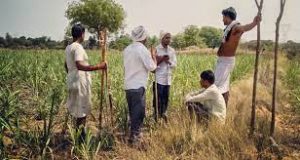
The Ministry of Agriculture has signed a Memorandum of Understanding with Microsoft to run a pilot programme for 100 villages in 6 states.
- The MoU requires Microsoft to create a ‘Unified Farmer Service Interface’ through its cloud computing services.
- This comprises a major part of the ministry’s plan of creating ‘AgriStack’ (a collection of technology-based interventions in agriculture), on which everything else will be built.
About AgriStack:
- It is a collection of technologies and digital databases that focuses on farmers and the agricultural sector.
- AgriStack will create a unified platform for farmers to provide them end to end services across the agriculture food value chain.
- It is in line with the Centre’s Digital India programme, aimed at providing a broader push to digitise data in India, from land titles to medical records.
- The government is also implementing the National Land Records Modernisation Programme (NRLMP).
- Under the programme, each farmer will have a unique digital identification (farmers’ ID) that contains personal details, information about the land they farm, as well as production and financial details.
- Each ID will be linked to the individual’s digital national ID Aadhaar.
Financial Action Task Force (FATF):

The Financial Action Task Force (FATF) decided to retain Pakistan on “increased monitoring list’.
- “Increased monitoring list” is another name for the Grey List.
- The FATF had issued the 27-point action plan after placing Pakistan on the ‘Grey List’ in June 2018. The action plan pertains to curbing money laundering and terror financing.
- During the October-2020 Plenary, due to the Covid-19 pandemic, Pakistan was given an extension for full compliance with the 27-point action plan till February 2021.
- It had then not fully complied with 6 of the 27 directives.
- In February 2021, FATF acknowledged Pakistan’s significant progress in combating terrorism, however it was still to fully comply with three of the 27-point action plan.
- The three points pertained to effective steps in terms of financial sanctions and penalties against the terror funding infrastructure and the entities involved.
- The FATF said Pakistan had failed to take appropriate action against UN-designated terrorists such as 26/11 accused Hafiz Saeed and JeM chief Masood Azhar. However, Pakistan has completed 26 of the 27 action items.
- The FATF encourages Pakistan to continue to make progress to address as soon as possible the one remaining Countering Finance of Terrorism (CFT)-related item by demonstrating that Terror Financing investigations and prosecutions target senior leaders and commanders of UN-designated terrorist groups.
- In addition, the FATF has handed down another 6-point list of tasks mainly on money laundering actions to be completed as well.
- Pakistan is expected to amend its Money-Laundering Act, crackdown on Designated Non-Financial Businesses and Professions (DNFBPs) like real estate agencies and gemstone traders, confiscate and freeze assets of money laundering entities and monitor businesses for proliferation financing, with sanctions for non-compliance.
Financial Action Task Force:
- It is an inter-governmental body established in 1989 during the G7 Summit in Paris.
- The FATF assesses the strength of a country’s anti-money laundering and anti-terror financing frameworks, however it does not go by individual cases.
- Objectives:
- To set standards and promote effective implementation of legal, regulatory and operational measures for combating money laundering, terrorist financing and other related threats to the integrity of the international financial system.
- Headquarters:
- Its Secretariat is located at the Organisation for Economic Cooperation and Development (OECD) headquarters in Paris.
- Member Countries:
- The FATF currently has 39 members including two regional organisations — the European Commission and Gulf Cooperation Council. India is a member of the FATF.
- Lists under FATF:
- Grey List:
- Countries that are considered safe haven for supporting terror funding and money laundering are put in the FATF grey list.
- This inclusion serves as a warning to the country that it may enter the blacklist.
- Black List:
- Countries known as Non-Cooperative Countries or Territories (NCCTs) are put in the blacklist.
- These countries support terror funding and money laundering activities.
- The FATF revises the blacklist regularly, adding or deleting entries.
- Grey List:
The World Drug Report 2021: UNODC:

The United Nations Office on Drugs and Crime (UNODC), in its World Drug Report 2021, has highlighted that the lockdown restrictions during Covid-19 have accelerated drug trafficking using the Internet.
- By drugs, the Report refers to substances controlled under international drug control conventions, and their non-medical use.
Data Analysis:
- Between 2010-2019, the number of people using drugs increased by 22%, owing in part to an increase in the global population.
- Around 275 million people used drugs worldwide last year, while over 36 million people suffered from drug use disorders.
Opioids continue to account for the largest burden of disease attributed to drug use. - A rise in the non-medical use of pharmaceutical drugs was also observed during the coronavirus pandemic.
Cannabis is More Potent but Fewer Young People See it as Harmful:
- In the last 24 years, cannabis potency had increased as much as four times in some parts, even as the percentage of adolescents who perceived the drug as harmful fell by as much as 40%.
- The major psychoactive constituent in cannabis, Δ9-THC, is responsible for the development of mental health disorders, in the long-term.
- Reason: Aggressive marketing of cannabis products and promotion through social-media channels.
Rising Web-based Sales Could Transform Global Drug Use Patterns:
- Access to drugs has also become simpler than ever with online sales, and major drug markets on the dark web are now worth some $315 million annually.
- In Asia, China and India are mainly linked to shipment of drugs sold on the 19 major darknet markets analysed over 2011-2020.
- Cannabis dominates drug transactions on Dark web and on clear web involves sale of Narcotic Drugs and Psychotropic Substances (NDPS) and substances used in the manufacture of synthetic drugs.
Project Seabird:
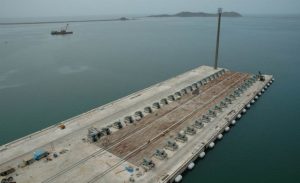
Raksha Mantri Shri Rajnath Singh visited the Karwar Naval Base in Karnataka on June 24, 2021 to review the progress of ongoing infrastructure development under ‘Project Seabird’.
- RM says it will be Asia’s largest Naval Base and further strengthen the operational readiness of the Armed Forces.
- INS Kadamba is an Indian Navy base located near Karwar in Karnataka.
- The first phase of construction of the base, code-named Project Seabird, was completed in 2005 and the base was commissioned on 31 May 2005.
- Development of Phase II commenced in 2011.
- INS Kadamba is currently the third largest Indian naval base, and is expected to become the largest naval base in the eastern hemisphere after completion of expansion Phase IIB.
Maritime State Development Council (MSDC):
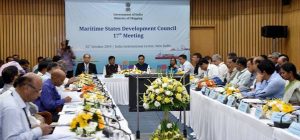
Union Minister of State (I/C) for Port, Shipping and Waterways Shri Mansukh Mandaviya chaired the 18th meeting of the Maritime State Development Council (MSDC) today through a video conference organized by the Ministry of Ports, Shipping and Waterways.
- MSDC is an apex advisory body for the development of the Maritime sector and aims to ensure integrated development of Major and non-Major Ports.
- The MSDC was constituted in May 1997 to assess in consultation with State Governments, the future development of existing and new Minor Ports by the respective Maritime States either directly or through captive users and private participation.
Pinaka Rocket:
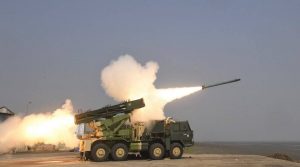
DRDO successfully test fired extended range version of indigenously developed Pinaka rocket from a Multi-Barrel Rocket Launcher (MBRL) on 24th and 25th June 2021 at Integrated Test Range (ITR), Chandipur off the coast of Odisha.
- The enhanced range version of Pinaka Rocket System can destroy targets at distances up to 45 kms.
- The rocket system has been developed jointly by Pune based Armament Research and Development Establishment (ARDE) and High Energy Materials Research Laboratory (HEMRL) with manufacturing support from M/s Economic Explosives Limited, Nagpur.
- The Pinaka is a multi-barrel rocket launch system that can fire a salvo of 12 rockets in 44 seconds. The weapon system, mounted on a Tatra truck, is equipped with state-of-the-art guidance kit comprising an advanced navigation and control system.
- The Navigation system of the missile is also aided by the Indian Regional Navigation Satellite System (IRNSS).
Employee’s Compensation Under The Code On Social Security, 2020:

Ministry of Labour and Employment has notified the draft rules relating to Employee’s Compensation under the Code on Social Security, 2020 for suggestions.
- The Code on Social Security, 2020 amends and consolidates the laws relating to social security to extend social security to employees and workers in the organised as well as unorganised sectors.
- Chapter VII (Employee’s Compensation) of the Social Security Code, 2020 envisages, inter-alia, provisions relating to employer’s liability for compensation in case of fatal accidents, serious bodily injuries or occupational diseases.
- The draft Employee’s Compensation rules notified by the Central Government provide for the
- provisions relating to manner of application for claim or settlement,
- rate of interest for delayed payment of compensation,
- venue of proceedings and transfer of matters, notice and manner of transmitting money from one competent authority to another and
- arrangements with other countries for the transfer of money paid as compensation.




